Last Updated on July 15, 2022 by Staff
The Scissorhand Grip is a “functional crossed type” chopstick grip, a term we have refined from an enduring but mistaken concept about “crossedness”. It is in fact the first functional crossed grip we published on marcosticks.org.
But a more accurate classification of Scissorhand defines it as an Under Swing variant of Chicken Claws.
Table of Contents
Scissorhand vs. Chicken Claws
We have published so far 8 articles on a variety of what the public and previous researchers call “parallel type” chopstick grips, as of this writing. One reason for the delay on publishing crossed grips is the relative scarcity of crossed grips we have documented in the wild. We have amassed a lot more video footage of parallel grips than crossed grips. Another reason is the unexpected difficulty in drawing a crossed-grip branch on the family tree of alternative grips, separate from the parallel-grip branch.
We have belatedly come to realize that these crossed grips do not belong in one family branch by themselves, despite what most chopstick users believe, or what researchers think. Crossed grips share less in common amongst themselves, than each of these crossed grips share with some member in the parallel-grip branch that we’ve been trying to build. Once this “crossed vs. parallel” folly is cast aside, suddenly every crossed grip we’ve studied snaps in place next to a parallel grip we have analyzed and published.
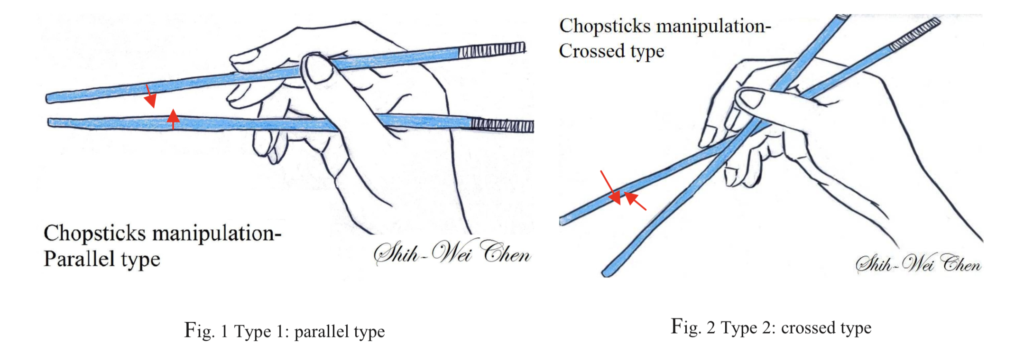
It turns out that (Edward) Scissorhand Grip is a direct descendant of Chicken Claws. Their relationship can be visually confirmed by their nearly identical closed postures, as shown below*. Both grips share the hallmark feature of Chicken Claws – the complete abandonment of the tip segment of the thumb in chopstick manipulation. In both grips, the top chopstick (indicated by white arrows) completely abuts the bottom chopstick, at the closed posture. As a result, both chopsticks are supported at this point by the distal knuckle of the middle finger. This is different from the Standard Grip, the distant ancestor of both grips. Under Standard Grip, only the top chopstick is supported by the middle finger; the bottom chopstick rests on the ring finger instead.
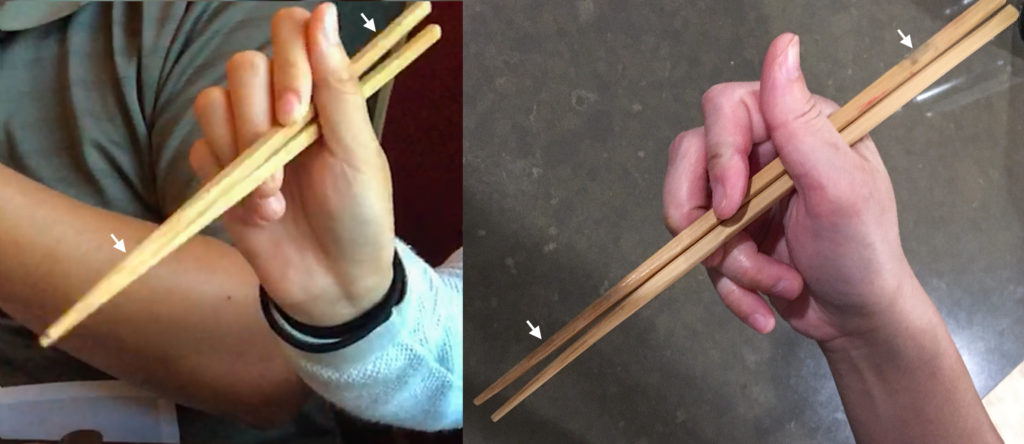
The two grips differ, however, in how the top chopstick is moved, when a user extends tips of sticks apart. A “parallel” grip such as Chicken Claws pulls the top chopstick upward, as shown below to the right. We classify Chicken Claws as a Classic Swing variant. A “functionally crossed” grip such as Scissorhand Grip, however, has the tip of the top chopstick “cross” over under the bottom chopstick, as shown below to the left. We classify Scissorhand Grip as an Under Swing variant of Chicken Claws.

Crossedness and Under Swing
Conventional views of chopsticks treat any stick configuration forming a cross figure as belonging to the crossed type. But we shall differ in how we define “crossedness”, at marcosticks.org. We always explicitly quality it as either functional crossing or non-functional crossing, if we must mention crossing at all. Usually we jettison the word “crossing” in favor of describing the way the tip of a top chopstick is flung as Classic Swing, Under Swing and Sideway Swing.
We define Under Swing as state where the tip of the top chopstick crosses the bottom chopstick, to end up below the bottom chopstick, instead of above it.
To illustrate the point, three pictures of chopstick grips are shown below. All of them are shots of chopsticks in motion, between the closed posture and the open posture. At a glance, the left picture and the middle picture appear to show crossed-type grips, while the right picture shows a parallel-type grip. But that is not correct. The middle picture and the right picture are in fact both the Dangling Stick grip, a parallel-type grip. It’s just that the user in the middle picture holds chopsticks close to the center of sticks, while the picture to the right shows chopsticks held close to the rear.

Following are pictures of the the same three users extending tips of chopsticks wide apart, at the open posture. Again, the left picture and the middle picture look at a glance like crossed-type grips. But upon closer inspection, it can be confirmed that, in the left picture, the top chopstick crosses inward and down, past the bottom chopstick. In the middle picture, the top chopstick extends outward and up instead.
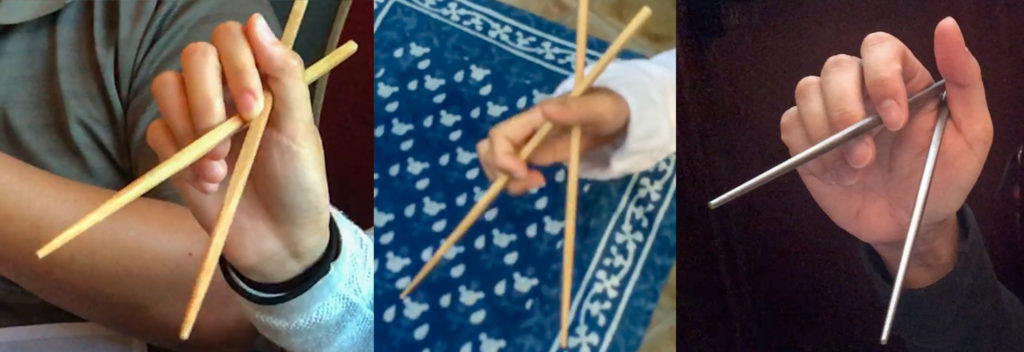
Spread tips apart using third-class lever
Following videos illustrate how the index finger pushes the top chopstick downward, in order to extend tips of chopsticks apart*. Note how the base of the thumb moves toward the rear end at the same time, in order to make room for the top chopstick to slide down. Unlike the Standard Grip which resembles a planetary gear train, the Scissorhand Grip employs the third-class lever principle, when extending chopsticks apart (but not when closing tips). The pivot point is the contact between the two chopsticks. This pivot point shifts as the top chopstick slides along the bottom chopstick.
The above video shows the wrist rotating as chopstick tips are spread apart. Note how the user makes use of gravity to assist in achieving a wide open posture. The top stick is gently “allowed” to remain pointing down, by the base of the thumb reducing its squeeze during the maneuver. This is a subtle gravity assist. Other alternative grips such as Dangling Stick and Cupped Vulcan make more explicit use of gravity.
Following sequence of pictures illustrate the index finger flattening as it applies pressure to push the top chopstick down, “under” the bottom chopstick, in a Under Swing motion. In the sequence shown below, the user places the back of her hand on the table. Unlike videos shown above, there is no gravity assist in this case, to help pull the tip of the top chopstick downward.
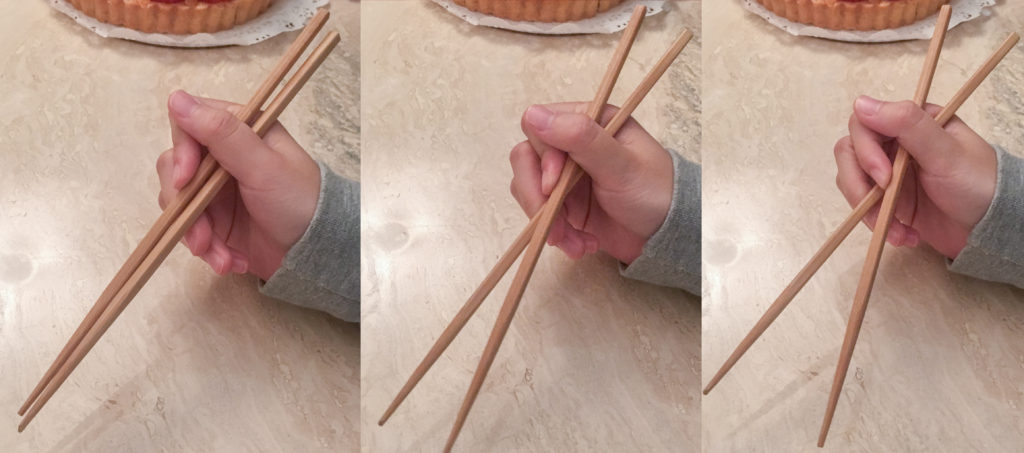
Close tips by squeezing with the thumb
Following videos show the full alternating motion of this grip, from two different angles. It can be visually confirmed that there is a substantial sideway movement to this alternative motion, similar to Dangling Stick and Dino Claws. The underlying reason for this similarity is the way these grips close chopsticks – all of them rely on the base of the thumb flattening both chopsticks against fingers.
Following sequence of pictures illustrate this squeezing of chopsticks by the thumb. Note the flattening of the thumb as it squeezes the two chopsticks closed.

Closing salad tongs
Scissorhand Grip generates only a weak compression force, when put to our favorite salad tongs test. Following videos demonstrate that fingers alone are unable to close salad tongs. Instead, the user resorts to toppling tongs to one side. The user then puts the whole weight of the arm and the palm on the other side, against the ground surface. Thus, the tongs are effectively closed by the bottom chopstick and the ground surface.
Also notice how the index finger is relieved of duties during compression. This is reminiscent of a similar gesture in Dino Claws, shown below to the right. In the case of Scissorhand Grip, the index finger is lifted away, so that it does not get in the way of the thumb. This makes room for the thumb to push both chopsticks flat against the purlicue and the distal knuckle of the middle finger, as the thumb attempts to bring tips of chopsticks together.
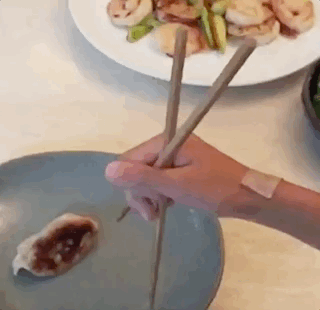
Compression force
The compression force of Scissorhand Grip is weak, compared to Standard Grip, as stated earlier, due to several factors. To generate compression, the two sticks must move sideways towards each another. The slope of the knuckle of the middle finger does not provide a good pushing surface for the bottom chopstick. In addition, the moving pivot of the top chopstick works against the intended goal. The attempt of the thumb to flatten the top chopstick sideways instead causes the top chopstick to drag along the bottom chopstick, as if sharpening the top stick against the bottom stick. Lastly, just like Dangling Stick and Dino Claws, this grip pinches food items, while chopsticks form an outward extending angle. This reversed angle, compared to Standard Grip shown below to the right, allows food items to slip away.
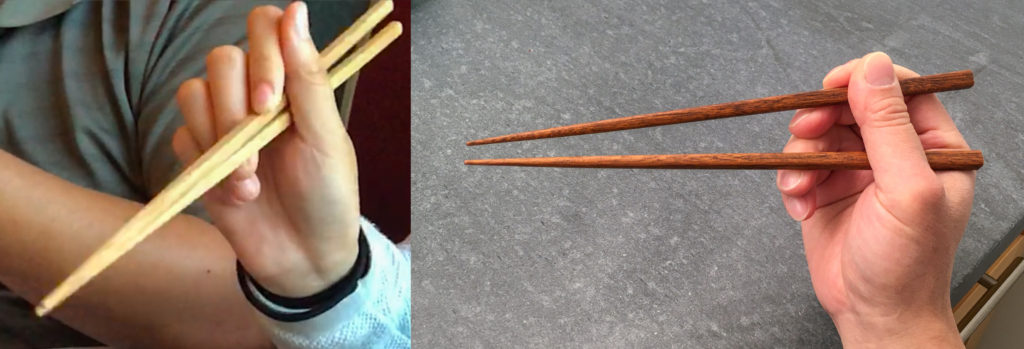
Extension force
Scissorhand Grip generates more extension forces than many other grips such as Finger Pistol. One reason is because it uses finger muscles that “flex” fingers instead of muscles that “extend” fingers. The human hand and fingers generate far more compression forces than extension forces. Scissorhand leverages this to extend chopstick tips apart.
With that said, Scissorhand still lack extension power, compared to Standard Grip, due to two factors. The first is the same issue as with compression – the bottom chopstick isn’t securely held to resist sideway forces, due to the sloped knuckle surface of the middle finger. Secondly, the index finger pushes against a moving pivot which is between the index finger and the thumb, when little resistance is felt. When greater resistance is encountered, however, as is the case in videos shown below, the thumb takes up the the role of the pivot. But the base of the thumb is not sloped to provide a perpendicular surface for this job.
Real world situations
Notwithstanding the lack of power, Scissorhand Grip still works well in most eating situations. The fact is that real world situations calls for few strenuous extensions. In most cases, a small extension angle and a feeble compression force is all that is needed. The following video illustrates the usual range of movements called for. The sideway movement is exaggerated in these small movements.
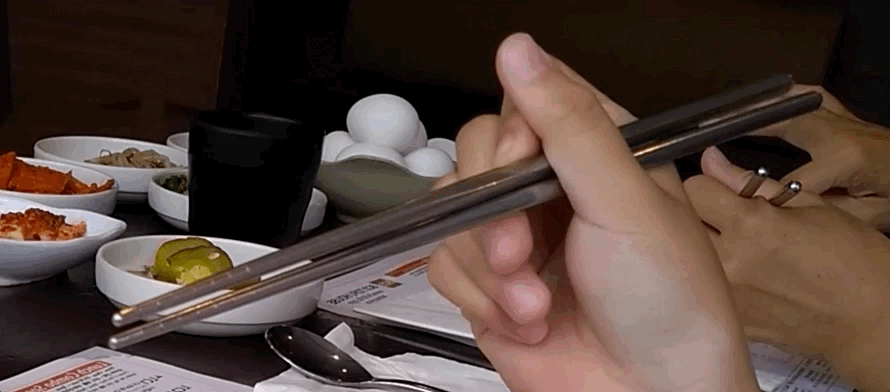
The video below to the left demonstrates that such small movements are more than adequate for picking up french fries. The picture below to the right shows broccoli being picked up with chopsticks.
Four generations away from Standard Grip
On the family tree of alternative grips, the Scissorhand Grip is located four generations away from the Standard Grip at the top of the tree. It claims Chicken Claws as its parent, and counts Dangling Stick and Dino Claws as its siblings. When videos of Scissorhand Grip are shown next to Standard Grip videos as illustrated below, cumulative effects of four generations of changes become obvious.
Lateral chopstick grips
(Added 2021-05) It took us two years of data collection, before we discovered the largest chopstick grip family, the Lateral chopstick grips. And it turns out that Scissorhand is a remote relative of these Lateral grips.
Take a look at the following member of the Lateral grip family. It is an under-swing variant of Lateral Classic, just like Scissorhand is an under-swing variant of Chicken Claws.
Now, compare the above to Scissorhand, shown below. The resemblance is uncanny, especially at the Abutting posture shown to the left.
But one should also note subtle differences that make Scissorhand deserve its own grip name, outside of the Lateral family. Look at the Max open postures shown on the right above, of Underswing Lateral, and of Scissorhand. In Underswing Lateral, the bottom chopstick always rests on the middle finger, even in the Max open posture. In Scissorhand, the bottom chopstick is pushed far away downward, such that it no longer rests on the middle finger. In fact, only the base of the thumb holds the bottom chopstick at the Max open posture, and prevents it from falling off the hand.
Scissorhand is thus fundamentally different from all Lateral grips. In its Open posture and Max open posture, it morphs from a Lateral grip to a completely different beast. Its middle finger no longer makes contact with the bottom chopstick.
Another difference between Scissorhand and Underswing Lateral is how the index tip is used. The picture found below right shows the tip of the index finger being inserted between the two chopsticks, to nudge the top chopstick downward. That is not how the index finger works in Scissorhand.
In popular culture: the World Friends video
In May 2021 we analyzed an excellent episode on chopsticks and chopsticking by World Friends YouTube channel. We published a writeup of this review in YouTube episode on chopsticking from WorldFriends.
All three hostesses wield more than one chopstick grips. Two of three hostesses naturally use Lateral compression. The hostess Hyejin believes that she primarily uses Scissorhand. But actual observations show that she switches to Lateral Thumb Wrestler as often as she uses Scissorhand. These two grips differ only in how they extend chopsticks apart. Both grips clutch chopsticks closed with the same Compression posture.
Compare her perfect Scissorhand posture to our type specimen picture. Ignore the tip segment of the thumb. It is unused. So it may be curled or extended flat, without affecting chopstick operations.
Following are various perspectives of her Scissorhand grip, at the Open posture.
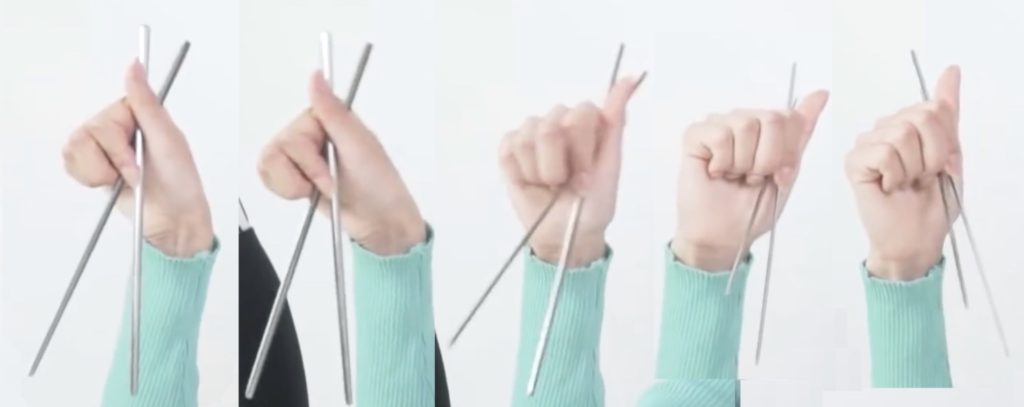
Following videos show that Hyejin’s finger movements are identical to what we have previously recorded from a Scissorhand practitioner. This is what we call an underswing movement (for the top chopstick).
Nayeon’s Scissorhand grip
In August 2021 we analyzed chopstick grips of all nine members of TWICE. While many members wield more than one grips, Nayeon specializes in Scissorhand.
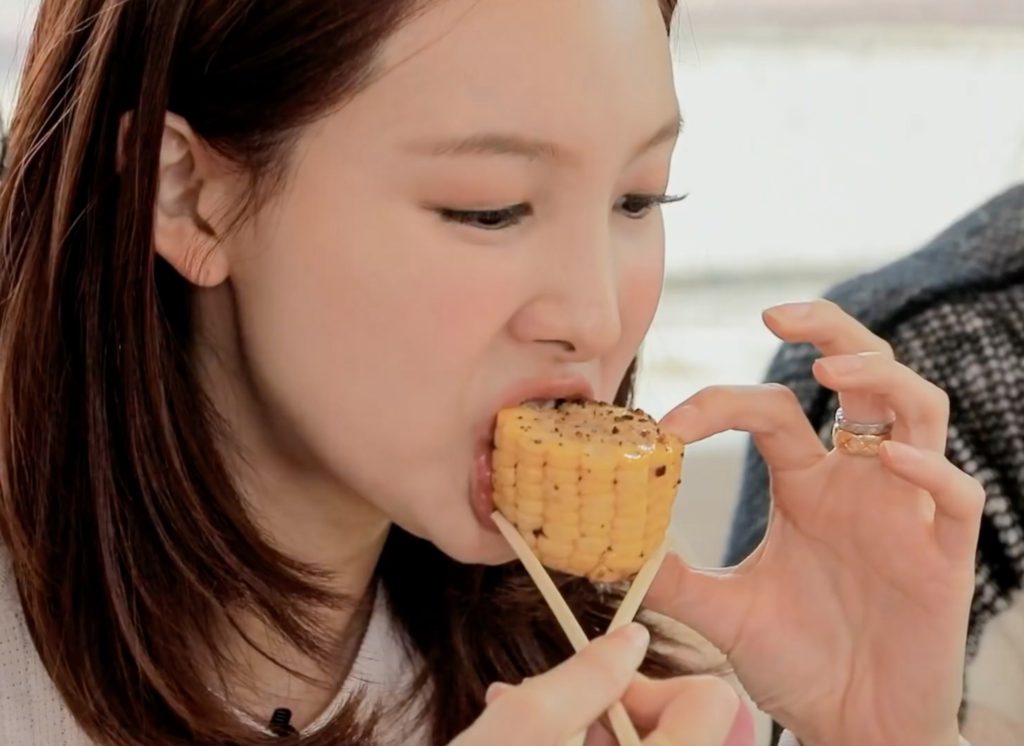
As mentioned earlier, Scissorhand is an underswing variant of Chicken Claws. It shares the same abutting posture as Chicken Claws, where two chopsticks are clutched together with almost no separation.
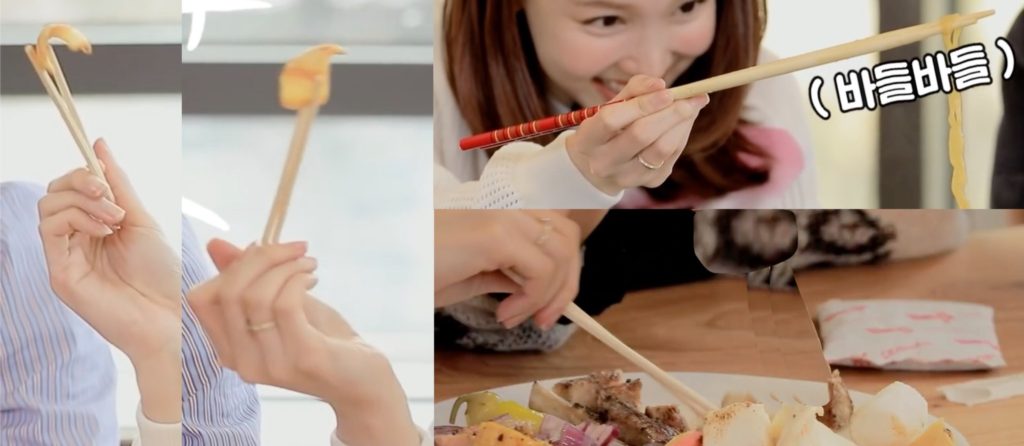
The relaxed open posture is observed from various perspectives, shown below.
Here we have Nayeon pinching and picking up food with this underswing grip. Note how the index finger squashes the top chopstick against the bottom chopstick which is held up by the knuckle of the middle finger.
In addition to the index finger and middle finger, the thumb is also instrumental in clutching chopsticks together.

In YesNo episode 3, Nayeon was given long cooking chopsticks, with tapered tips. Picking up noodles using a grip with Lateral compression is already hard. This is exacerbated when with these long and tapered chopsticks. Clutching chopsticks shut at the mid point leaves wide gaps at the tips of chopsticks in this case, as shown below. We have discussed this issue previously in the WorldFriend article, when describing Jane’s Double Hook grip with a Lateral compression.

Rolling the bottom chopstick
Here is a Scissorhand practitioner who rolls the bottom chopstick while extending tips apart. Usually a practitioner focuses on prying the top chopstick downward with the index finger. But this practitioner also prods the bottom chopstick upward, using rolling action.
Here is the same clip with interesting parts slowed down at various speed, including 10x slower. Consult the article Learn to Use Chopsticks for what “rolling” means. Search for “twirl” or “roll”. Or jump to this section: Twirl with the air quote gesture.
In fact, the rolling of the bottom chopstick makes this variant of Scissorhand look a bit similar to a variant of the Italian Grip where the practitioner rolls the same bottom chopstick.
Learn new grips
Users of Scissorhand Grip may learn to twirl chopsticks with Standard Grip, thus increasing their leverage on food items. This can be done by mastering the 1-on-2-support technique for holding the bottom chopstick, and the tripod hold technique for manipulating the top chopstick. Try using more than one chopstick grips at dinners – it turns into interesting conversation topics. Trust us.
* Videos in this article appear to depict this particular Scissorhand Grip user as right-handed. In fact, she is left-handed. All Scissorhand videos shown in this article have been flipped, to make it easier for readers to compare them to videos of other alternative grips, all of which have been recorded with right-handed users.
This is the first time we see Scissorhand in popular culture. But we think we’ll find more.
Taiwanese: 鉸刀手
This grip is known as 鉸刀手 (Ka-to chhiú) in Taiwanese.
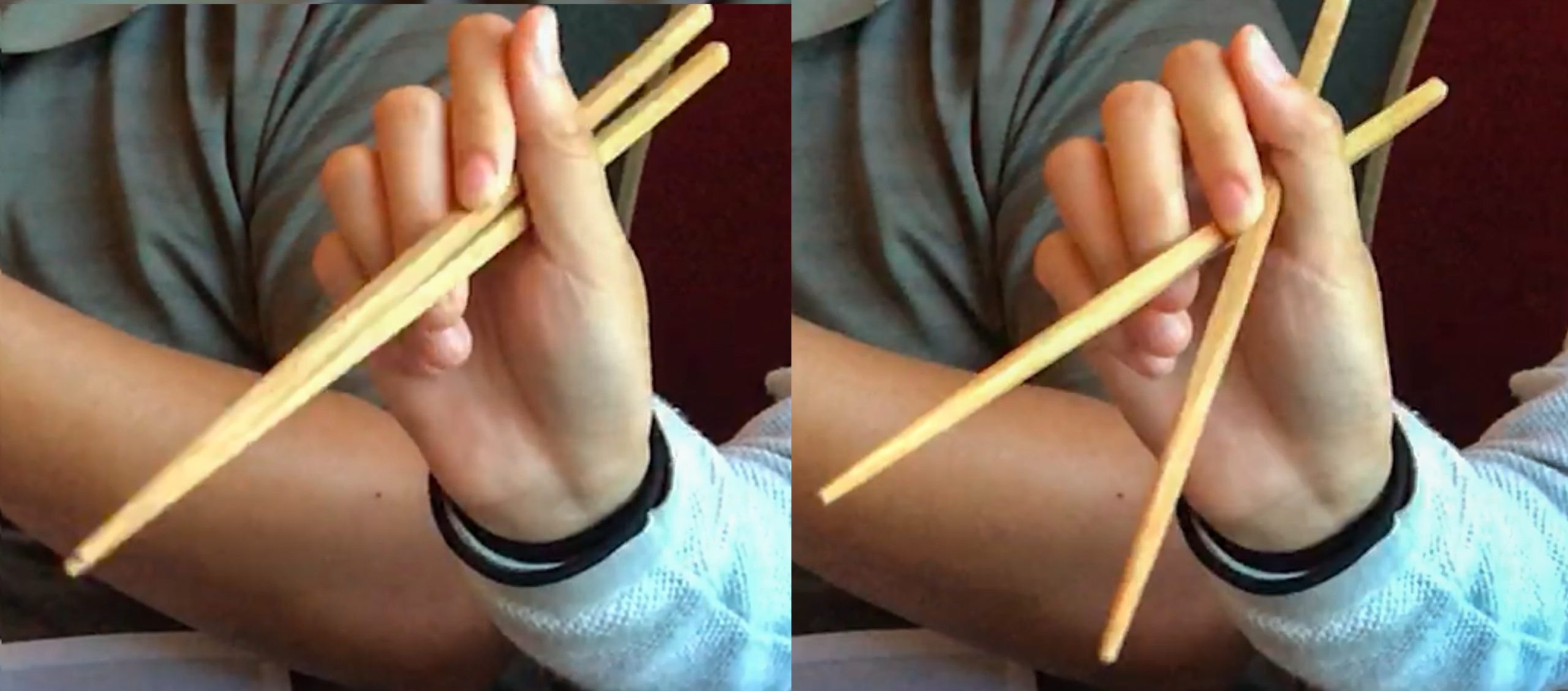

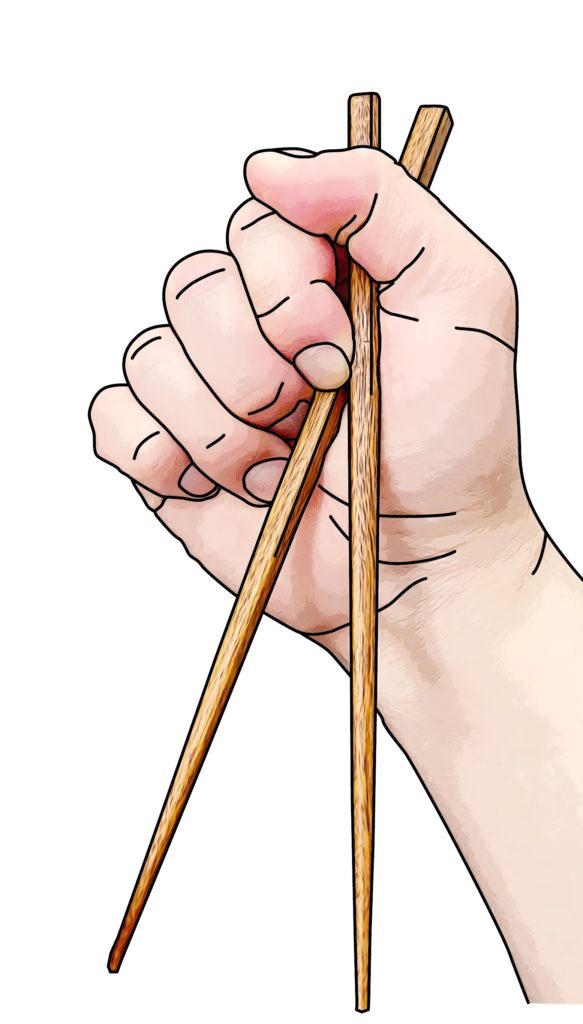
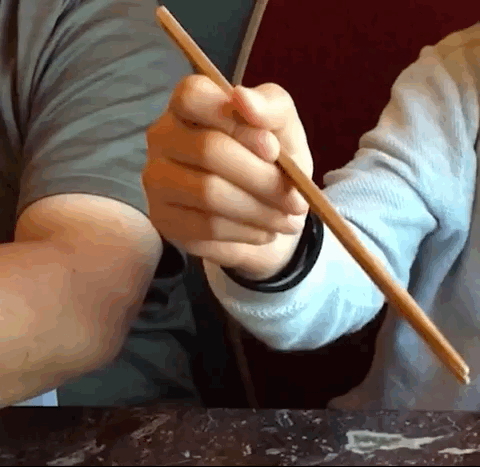
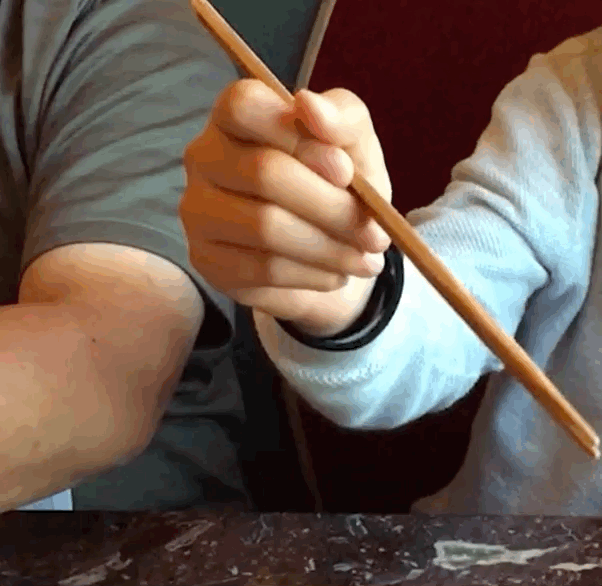
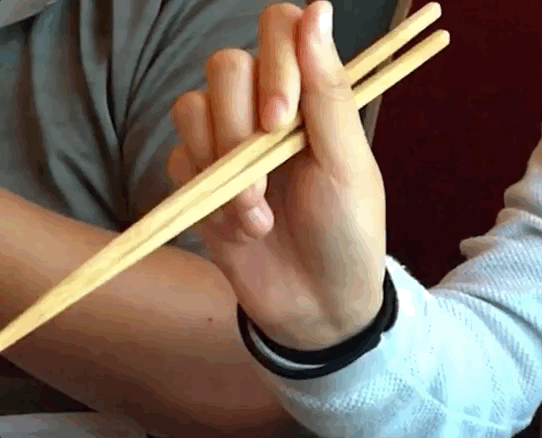
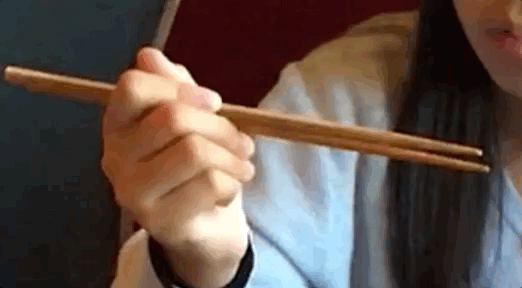
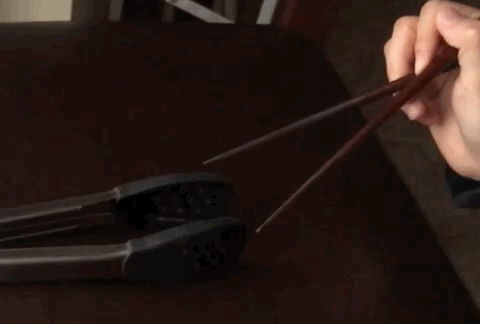
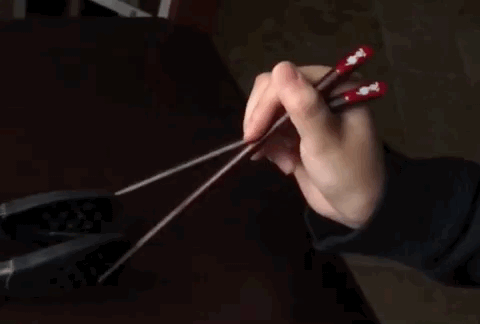
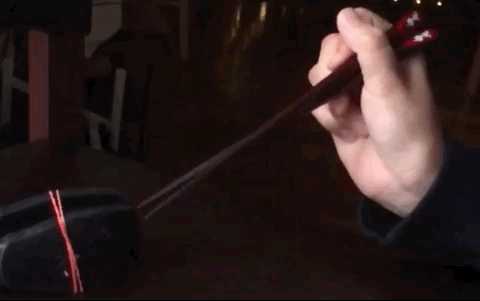
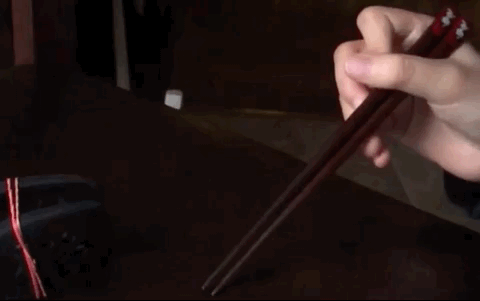
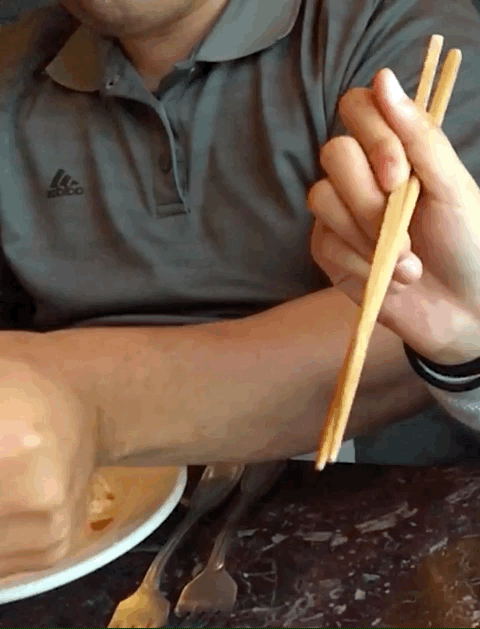
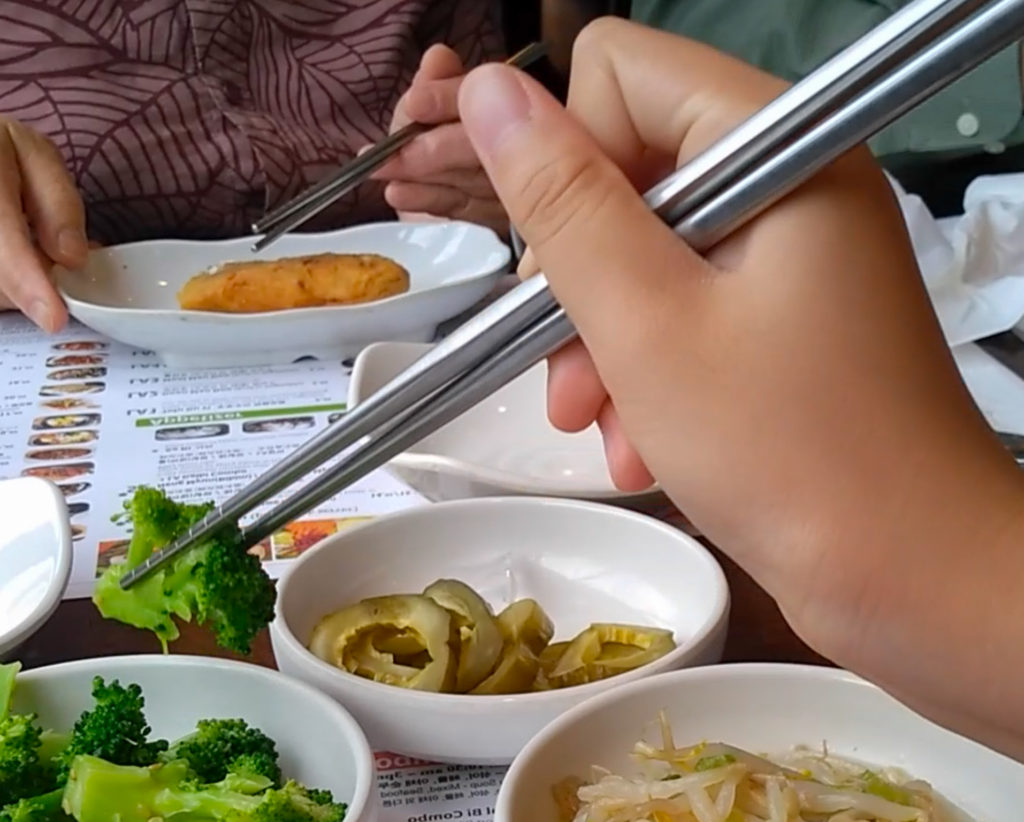
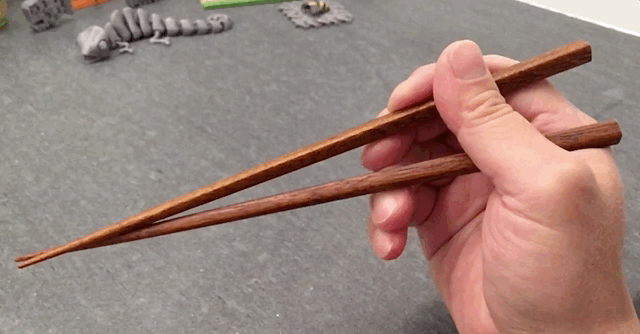

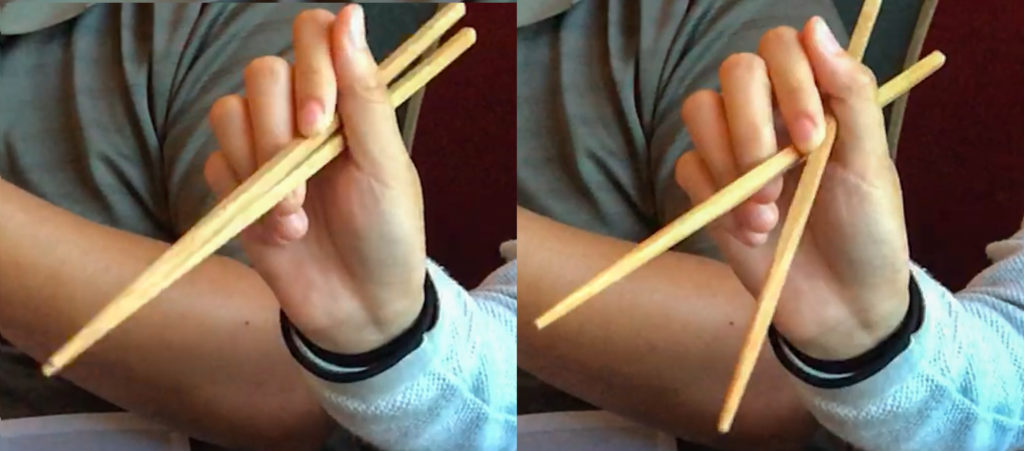
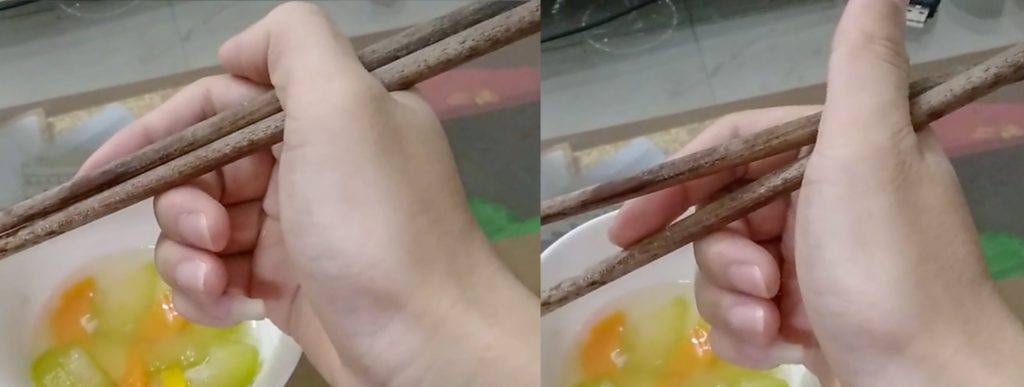
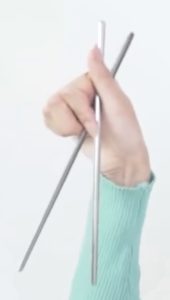
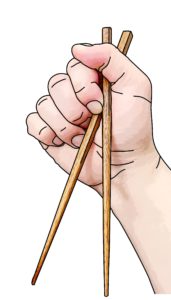
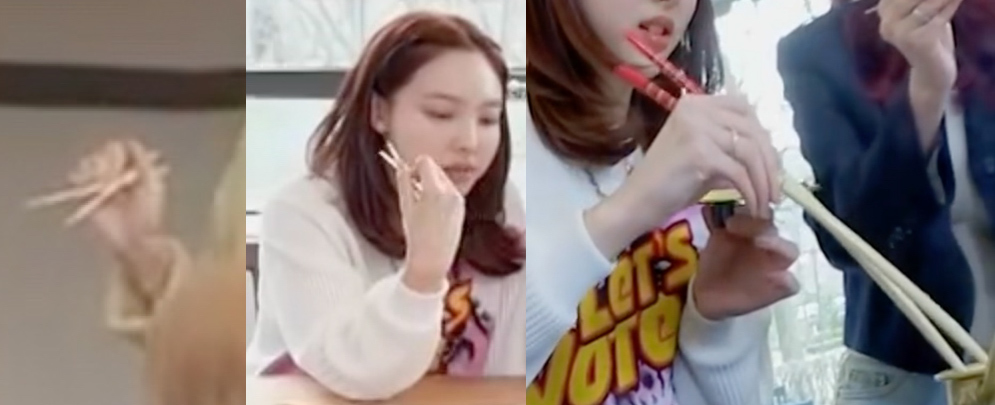
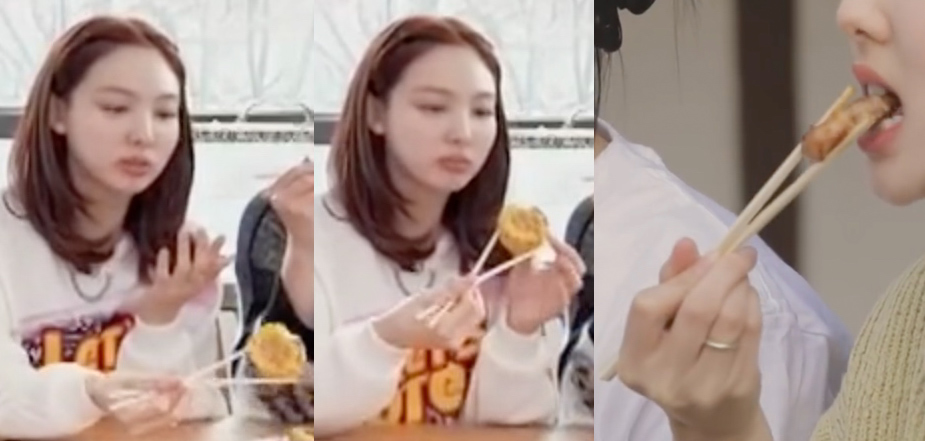
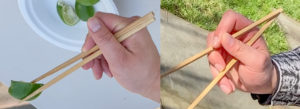

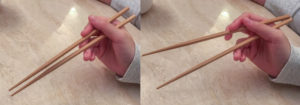
My grip is kind off similar to the last video’s. Compared to the standard scissor, the hand is more open, can open wider and the middle finger helps in closing.
https://drive.google.com/file/d/14lpcxZtvVcSzQRyzcZFzu6a3SY_6796Z/view
Your picture seems to show that you use the Dangling Stick grip: https://marcosticks.org/the-dangling-stick-grip/.
But I can’t be sure based on just this one picture. The main reason is that I can’t tell which chopstick is on top of which chopstick in your picture, as the thumb base covers the intersection of the two sticks.
Both Dangling Stick and Scissorhand “look” crossed. But they are completely different, in many ways. If you compare pictures from the two articles, you will see that while both sticks look crossed in both grips, in Dangling Stick the “top” chopstick points up, held by two fingers, and in Scissorhand the “top” chopstick points down, pushed downward by the eindex finger.
Can you check and confirm?
And, can we use your picture in our articles?
Thanks!